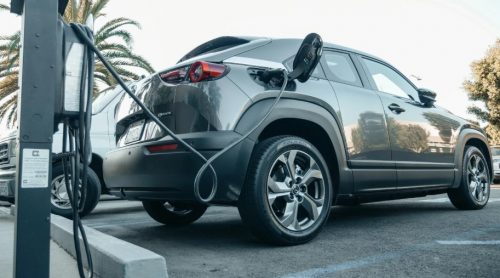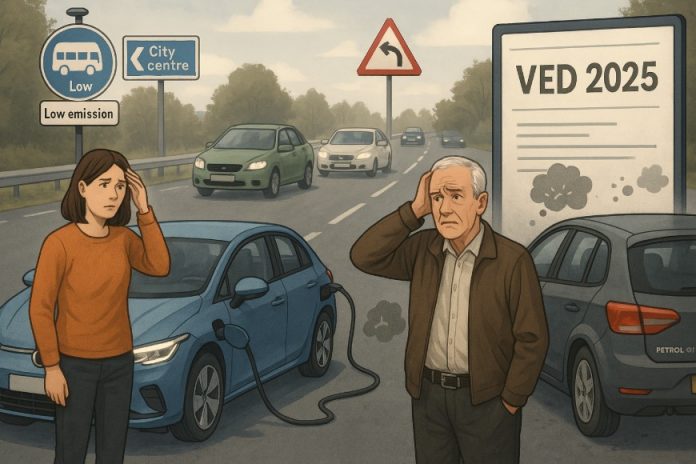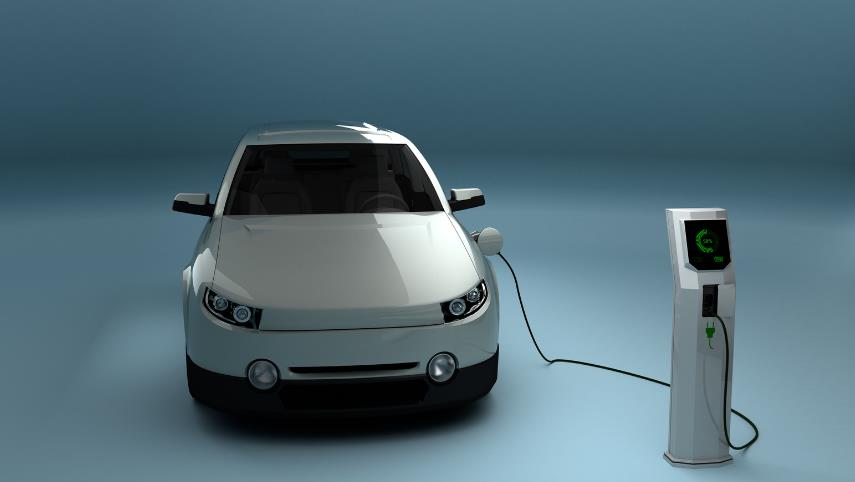From 1 April 2025, significant changes to car tax in the UK will impact a wide range of drivers, including older motorists and electric vehicle owners. These updates represent the biggest shift in Vehicle Excise Duty (VED) in almost a decade.
With first-year rates set to double for many new vehicles and EVs losing their exemption, understanding these developments is essential. This article explains how the new car tax changes in the UK will affect older drivers and electric vehicle owners.
What Are the Key Vehicle Excise Duty (VED) Changes Coming in April 2025?

From 1 April 2025, the UK government will implement a major revision of Vehicle Excise Duty (VED), commonly referred to as road tax.
This reform marks the largest overhaul since the introduction of a standardised flat rate system in 2017. The updated policy targets first-year VED rates, particularly for high-emission and combustion engine vehicles.
These changes aim to strengthen the financial incentive to purchase electric and low-emission vehicles while also ensuring the sustainability of government revenues as fuel duty income declines.
The new rates are designed to reflect a vehicle’s environmental impact more accurately, especially regarding carbon dioxide emissions.
First-year tax rates will double for nearly every petrol, diesel, and hybrid model sold after 1 April. Furthermore, electric vehicles, previously exempt from VED, will now be required to pay road tax starting from the same date.
This system supports the government’s transition strategy toward cleaner transportation by penalising vehicles with higher environmental footprints.
The changes were confirmed in the Chancellor’s 2024 Autumn Budget, where it was stated that the reform would help raise approximately £400 million annually for the Treasury.
How Will These Car Tax Reforms Impact Older Drivers in the UK?
The VED changes will have a notable impact on older drivers, many of whom are retirees or pensioners with fixed incomes.
A significant portion of this demographic tends to own older or higher-emission vehicles due to cost, familiarity, and practicality. These vehicles are more likely to fall into the higher VED brackets, resulting in increased financial burdens.
Older drivers are also less likely to switch to electric vehicles in the short term. Reasons include limited digital literacy, reduced confidence in adapting to new technology, and concerns over the practicality of charging infrastructure.
Additionally, EVs often have higher upfront costs compared to conventional petrol or diesel cars, making them less attractive to those on a limited budget.
Only 48 per cent of UK motorists are currently aware of the upcoming VED changes, according to a Go Compare survey. This figure may be even lower among senior drivers, highlighting the need for increased public awareness campaigns targeted at this group.
Why Are Electric Vehicle Owners Being Taxed for the First Time?
As electric vehicles have become more prevalent, the government has moved to introduce a fairer taxation model. Until now, battery-electric vehicles were exempt from VED to encourage adoption and reduce the country’s reliance on fossil fuels.
However, with EV ownership increasing rapidly, the rationale for continuing zero-rated tax has diminished.
From April 2025, all EVs registered after that date will be subject to VED. The first-year rate will be modest at £10, with a standard rate applied in subsequent years. This marks a departure from the policy introduced in 2017, where emissions-free vehicles were categorised in the £0 tax band.
The government has justified this change by pointing out the need to balance revenue as fuel duty falls. Since EVs do not consume petrol or diesel, owners contribute less to road maintenance and other public infrastructure through traditional fuel taxation.
Introducing VED for electric cars ensures that all drivers contribute to these costs, regardless of the type of vehicle they own.
How Much Will You Pay in First-Year Showroom Tax After 1 April 2025?

One of the most striking aspects of the reform is the doubling of first-year VED for new vehicles. These changes vary according to the vehicle’s CO2 emissions, with high-polluting cars facing the steepest increases. The table below outlines the revised rates for cars registered after 1 April 2025.
| CO2 Emissions (g/km) | First-Year VED (2024–25) | New First-Year VED (2025–26) | Increase |
| 0 | £0 | £10 | £10 |
| 1–50 | £10 | £110 | £100 |
| 51–75 | £30 | £130 | £100 |
| 76–90 | £135 | £270 | £135 |
| 91–100 | £175 | £350 | £175 |
| 101–110 | £195 | £390 | £195 |
| 111–130 | £220 | £440 | £220 |
| 131–150 | £270 | £540 | £270 |
| 151–170 | £680 | £1,360 | £680 |
| 171–190 | £1,095 | £2,190 | £1,095 |
| 191–225 | £1,650 | £3,300 | £1,650 |
| 226–255 | £2,340 | £4,680 | £2,340 |
| Over 255 | £2,745 | £5,490 | £2,745 |
The new rates are a deliberate attempt to push consumers toward cleaner vehicles. Buyers of cars producing more than 255g/km CO2 will pay up to £5,490 just in their first year of ownership.
This makes the cost of choosing a high-performance or gas-guzzling model significantly more expensive at the point of sale.
Which New Cars Will See the Highest Increase in Car Tax?
Luxury, performance, and large SUV models will bear the brunt of the VED hikes due to their high emissions output. Buyers of these vehicles will be subject to the maximum £5,490 first-year tax.
Examples of vehicles in this category include:
- Audi RSQ8, RS7, S8, R8
- Bentley Bentayga, Continental GT, Flying Spur
- Aston Martin DB12, DBX, Vantage
- BMW M8, X5M, X7M
- Mercedes-AMG GT, GLE63, G63, GLS63
- Ferrari Purosangue, Roma
- Lamborghini Urus, Revuelto
- Porsche 911 Turbo, Cayenne, Macan GTS
- Rolls-Royce Ghost, Cullinan
- Ford Mustang, Ranger Wildtrak
- Land Rover Defender V8, Range Rover Sport SV
These vehicles, often chosen for performance or luxury, will see the most dramatic increases in tax liability. The increased cost may lead to a shift in consumer behaviour, with buyers more likely to choose smaller, more efficient vehicles.
What Does This Mean for Hybrid and Plug-In Hybrid Vehicle Buyers?
Hybrid and plug-in hybrid vehicles will be affected by the changes, but to a lesser extent than traditional internal combustion engines. The government is introducing a new tiered VED system based on emissions for these types of vehicles, designed to encourage the purchase of ultra-low emission options.
The following table outlines the first-year VED costs for hybrid vehicles registered after 1 April 2025:
| Hybrid Type (CO2 g/km) | First-Year VED |
| 1–50 | £110 |
| 51–75 | £130 |
| Over 75 | Doubled standard rates (same as petrol/diesel) |
Only plug-in hybrids that emit under 50g/km of CO2 will benefit from significantly reduced rates. Standard hybrids and those with higher emissions will face tax increases similar to petrol and diesel vehicles.
Buyers considering hybrid models must now pay closer attention to CO2 ratings to avoid unexpected tax costs.
Are There Any Exemptions or Reliefs for Certain Drivers or Vehicles?

While the overall direction of the reform is to broaden the tax base, a few exemptions remain in place. These are primarily intended for specific categories of drivers or vehicles, and they include:
- Vehicles registered as historic (generally over 40 years old) will remain exempt from VED under existing rules.
- Drivers registered in the disabled tax class can continue to benefit from VED exemption or reductions, depending on their specific eligibility.
- Electric vans and some low-emission commercial vehicles may be taxed differently, depending on how they are used and registered.
These exemptions are narrowly focused and unlikely to benefit most mainstream car buyers. The policy direction clearly suggests that only truly low-emission or specially qualified vehicles will enjoy any financial relief.
How Can Drivers Prepare Financially for the Upcoming Tax Increases?
The increase in VED makes it more important than ever for consumers to plan their vehicle purchases carefully. Several steps can help motorists minimise their exposure to these higher costs:
- Purchasing a new vehicle before 1 April 2025 will allow buyers to take advantage of current, lower VED rates.
- Choosing cars with emissions under 75g/km CO2 can help limit tax liability, particularly in the first year.
- Reviewing used electric vehicles that were registered before April 2025 could be a smart way to avoid the incoming EV tax.
- Budgeting for increased costs, including fuel, insurance, and maintenance, can help drivers manage the total cost of ownership more effectively.
Consumers should also consult emission figures directly from vehicle manufacturers or DVLA records to determine the VED band of any prospective car.
How Can Electric Vehicle Owners Delay the New VED Charges?

Electric vehicle owners who already have a registered battery-electric car can take advantage of a legal method to defer the upcoming Vehicle Excise Duty charges set to begin in April 2025.
This strategy could help drivers save £195 by pushing their first VED payment into the 2026–27 financial year.
Currently, EVs are exempt from paying any road tax. However, starting from 1 April 2025, this exemption will be removed, and a standard annual rate of £195 will be introduced for zero-emission vehicles. Despite this change, there is a window of opportunity for current EV owners to act.
Motorists are not restricted to taxing their vehicles only when the existing tax period expires. They can voluntarily re-tax their vehicle at any time, even months in advance.
By choosing to re-tax a battery-electric vehicle on 31 March 2025—just one day before the exemption ends—drivers can secure another full year of VED-free motoring.
Key points for EV owners to consider:
- The re-taxing process can be completed online via the DVLA website.
- This voluntary taxation renews the car’s VED status from the chosen date for a full 12-month period.
- The strategy only applies to vehicles already registered as zero-emission before April 2025.
By taking action on 31 March, electric vehicle drivers can legally bypass the £195 charge for the 2025–26 year and only begin paying VED from April 2026.
This approach is particularly beneficial for households managing tight budgets or individuals looking to maximise their EV savings for another year.
This workaround is entirely compliant with current DVLA rules and offers a final opportunity to benefit from the longstanding EV tax exemption before the new policy takes effect.
What Are Experts Saying About the 2025 Car Tax Shake-Up?
Industry experts have responded with concern over the potential impact of the changes on new car sales, particularly for traditional combustion engine vehicles.
Tom Banks, an insurance specialist at Go Compare, warned that many buyers could be caught unaware of the increased costs, especially if they have not reviewed the latest tax band data.
The policy has also been described as a forceful push toward electric vehicle adoption. While the government positions it as a long-term environmental strategy, critics argue that it places additional pressure on buyers during a period when affordability is already a major concern due to inflation, interest rates, and high insurance premiums.
The automotive industry has acknowledged the need for change but has urged the government to pair higher taxes with stronger infrastructure investments, particularly in EV charging networks, to ensure the transition is viable for all consumers.
Conclusion
The new car tax changes in the UK will affect older drivers and electric vehicle owners more than most. With rising VED rates and the end of exemptions for zero-emission vehicles, planning ahead is now vital.
Older drivers may need to reconsider vehicle choices, while EV owners should prepare for new costs. As the government aligns taxation with environmental goals, staying informed and proactive will help motorists minimise financial impacts and adapt effectively to the new regulatory landscape.
FAQs About the 2025 UK Car Tax Changes
What is the reason for introducing car tax for electric vehicles now?
The government is responding to the increasing uptake of EVs by closing the tax gap and maintaining a balanced revenue model as fuel duty contributions decline.
Will existing EVs be taxed, or only new registrations?
All EVs, regardless of when they were purchased, will start incurring VED from April 2025, unless they fall under specific exemptions like mobility schemes.
Can I avoid the increased showroom tax by buying before April 2025?
Yes, purchasing a new vehicle before 1 April 2025 allows you to lock in the current VED rates, potentially saving thousands in tax.
Will used car buyers be affected by these changes?
Primarily, the increases apply to new car registrations post-1 April 2025. However, annual standard rate changes will still affect all car owners due to inflation-based adjustments.
Are there any special tax bands for low-income or retired drivers?
No specific relief exists for these groups, though some older vehicles and individuals with disabilities may qualify for exemption.
How do plug-in hybrids compare to EVs under the new tax rates?
Plug-in hybrids emitting less than 50g/km CO2 will pay £110 in the first year, which is higher than EVs (£10) but significantly lower than petrol or diesel cars.
Where can I check the emissions rating of my car?
Drivers can visit the DVLA or manufacturer websites to find the CO2 emissions rating of their specific model.





























